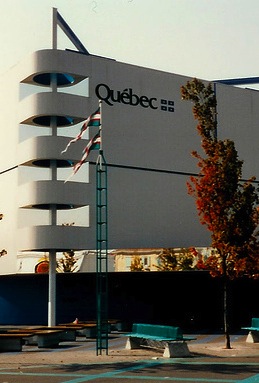Sunday, June 29, 1986.
WHAT DOES CENTRAL CANADA want? If the films on view at their provincial pavilions are any indication, both Ontario and Québec want to be known as places where the spirit of Expo 67 thrives.
Indeed, in an effort to relive that summer of glory, Ontario called upon David Mackay, producer of the Oscar-winning A Place to Stand. A cinematic stunner, it was the province's official film at the Montreal world's fair.
Given the job of designing, producing and directing Ontari-Oh!, the province's Expo 86 movie, Mackay came up with the idea of adding 3D to the now-familiar multiple-images presentation.
On view in the Ontario pavilion's 750-seat cinema, Mackay's bland, 20-minute production leaves no doubt that the creative genius behind A Place Stand was its director, Christopher Chapman. Without Chapman's involvement, Mackay has delivered a picture sadly lacking in either impact or inspiration.
Here, he had two remarkable tools at his disposal: the ability to vary the size and number of screen images and the reality-enhancing illusion of 3D. Unfortunately, Mackay shows no aptitude for developing a narrative drive with either one.
The single memorable shot in his film is that of Canada geese in flight, their wingtips extended out over the audience. Ontario would have done better recycling Chapman's golden oldie.
Québec, by contrast, was something of a cinematic non-starter at Expo 67. To redress the balance, la belle province devotes its entire Expo 86 pavilion to an absorbing multi-media production called L'Anneau Magique (The Magic Ring).
Designed to accommodate 100 fairgoers at a time, Québec's show area is an island surrounded by water and a 360-degree seamless screen, an environment that creates the effect of standing inside a hydroelectric dynamo. The presentation begins with 11-year-old Isabelle (Johanne McKay), a Québecoise schoolgirl, calling out to a boy from B.C. named Stephen (Stephen McKay, who is no kin to Johanne). Each child appears on a separate large screen television monitor.
Isabelle promises to show Stephen "what Québec is," and does so in a terrific 15-minute slide show enhanced by laser effects and a multi-channel soundtrack.
Unlike the Ontario film, Québec's show creates a vivid impression of the province it represents. Director Carlos Ferrand puts across a coherent image of a modern urban society with deep historic roots, an awareness of the land and some appreciation of "the spirit of the water" that generates its power.
Produced for the province by Lambert and Lepage Labbe Inc., The Magic Ring is a concept that succeeds in keeping Québec's Expo spirit alive.
The above is a restored version of a Province review by Michael Walsh originally published in 1986. For additional information on this archived material, please visit my FAQ.
Afterword: Ontario and Québec — often referred to as Central Canada due to their power within our federal state — offered quite the contrast at Vancouver's world's fair, with one province a study in sobriety, the other seeming almost giddy. The artists chosen to direct their pavilions' films seemed very much in tune with the legislatures in Toronto and Québec City.
A Second World War veteran nearing the end of his career, Ontario's David Mackay already had an Oscar-winning Expo 67 film to his credit. Though born in Québec, he learned his craft at CBC-TV in Toronto during the pioneering years 1952-1962. Seeing the future, he founded his own production house, TDF Film, to make TV commercials and sponsored films such as director Christopher Chapman's much-honoured A Place to Stand. In 1971, recognizing the potential in the new IMAX film format, he launched David Mackay Ltd. The first independent producer/director to make movies for the company's big-screen venues, Mackay's contributions included 1973's Catch the Sun (1973), Ontario: Summertide (1976) and Silent Sky (1977). With the Expo 86 Ontari-Oh! commission, he was finally able to make a movie in 3D. For Mackay, its famous shot of flying geese seems to have been inspired by his own experience as a Royal Canadian Navy fighter pilot flying low-level photo surveillance missions. David Mackay died in 2009.
Québec's directorial choice, Carlos Ferrand, had just turned 40 when L'Anneau Magique premiered at Expo 86. Born in Peru, he was educated in the U.S. and Belgium before settling in Montréal in the mid-1970s. He learned his craft working as an assistant cameraman on independent features for such Canadian directors as Larry Kent and Allen Goldstein. Although he worked steadily as a cinematographer on commercials and documentary projects, Ferrand had but one directorial credit when Québec entrusted him with its Expo 86 presentation. That previous credit — Cimarrones, a 1982 documentary short about runaway African slaves in Peru — had demonstrated his social conscience, and the provincial bureaucrats were willing to take a chance on a filmmaker with passion. Following the success of his Expo 86 production, he pursued a career in Québec that included TV and theatrical documentary features as well as specialty films. Twelve years after L'Anneau Magique, Ferrand was the federal government's choice to produce its show for the Canada Pavilion at Lisbon's Expo 98. In 2015, Québec's Arts Council honoured him with its Michel Brault Career Award.
See also: The nine articles included in this, the second of four Expo 86 special reports, explore the pavilions of:
|
14: Expo 86 British Columbia 15: Expo 86 Canada/Washington State 16: Expo 86 Canada 17: Expo 86 California 18: Expo 86 Mexico/Cuba/USA |
